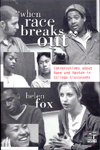While Northcott’s essay on teaching Aboriginal students spoke to my pedagogical interests, Tracy Lindberg’s essay,
On Indigenous Academia: The Hermeneutics of Indigenous Western Institutional Participation – Eleven Theorems poses questions that speak to my interests in public policy and Canadian history (both of which are severely underfed by study, but I find these topics fascinating nevertheless). Specifically, I wish to answer Lindberg’s question about
how the histories, employees and policies of Canadian institutions reflect Whiteness and White culture by examining the institution of Aboriginal schools and the governing body which oversees them – that is, the federal government. I will present a brief historical overview here, and then address Lindberg’s other question about
how individuals can address institutionalized Whiteness by commenting on how the policy has changed, and is still being changed, and what obstacles continue to persist.
Even before the British North America Act was written, the government’s policy with respect to Aboriginal education has been one of assimilation. Education would, as the minister of Indian affairs, Frank Oliver, predicted in 1908, "elevate the Indian from his condition of savagery" and "make him a self-supporting member of the state, and eventually a citizen in good standing."* This meant that the Aboriginal children were to learn English, and learn Catholicism. Not only that, but the policy unapologetically called for the complete eradication of the Aboriginal identity of the child, including, most importantly, language. Residential schools for aboriginal children were established across the nation which where jointly administered by the government and the Church, with the Church playing the dominant role. These schools were often far away from Indian reservations and so the children where severed from their parents to be cared for by strangers bent on transforming them into obedient, Christian subjects.
The tragic history of physical, emotional and sexual abuse that followed in these schools, up until as late as the 1980s, is well documented. It was commonplace to beat children for speaking their native languages and other indiscretions; the treatment was so terrible that many children ran away and died of exposure as they tried to find their way back to their homes. Death from diseases such as cholera and smallpox was also common.
The Legacy of Hope Foundation has a website up documenting the conditions in the residential schools and cataloging testimony from veterans. Below I have embedded a few of the interviews found on the
Where are the Children? webpage.
The fact that the residential schools were ineffective at producing good graduates is probably the least devastating legacy of the failed experiment. In 1992, a First Nations task force group forwarded to the minister of justice of the day, Kim Campbell, "a statement prepared and approved by B.C. First Nations Chiefs and leaders". In it, they pointed out that, “The federal government established the system of Indian residential schools which was operated by various church denominations. Therefore, both the federal government and churches must be held accountable for the pain inflicted upon our people. We are hurt, devastated and outraged. The effect of the Indian residential school system is like a disease ripping through our communities.”** Indeed, it is not very difficult to imagine why new generations of Aboriginals are weary of education in general, and federally-administered education in particular. Nor is it very difficult to imagine why many northern communities are devastated by widespread emotional and physical disorders such as depression, alcoholism and drug addiction. The legacy of the residential schools is inherited like a genetic affliction from parent to child, to grandchild.
 | A group of nuns with Aboriginal students, ca. 1890. Photographer: Library and Archives Canada, PA-123707 |
A watershed in the history of Aboriginal education occurred in 1972, when the National Indian Brotherhood (now called the
Assembly of First Nations) published a document demanding Aboriginal self-governance over education and outlining a plan for accomplishing this. The
Department of Indian and Northern Affairs readily accepted the proposal, and since then there has been a gradual transference of administrative powers form the federal government to the Aboriginal education authorities. Today, the vast majority of Aboriginal communities manage their own schools and, although there is still a significant gap in educational attainment between First Nation students and the general population, the proportion of First Nation students living on reserve who have completed high school has increased significantly.
In 1996, the
Royal Commission on Aboriginal Peoples strongly recommended the federal government give more control over education to the Aboriginal people, and recent policy papers suggest a move in this direction. In 1998, the Government of Canada responded to the Royal Commission’s recommendations with
Gathering Strength - Canada's Aboriginal Action Plan, which called for a renewed partnership with Aboriginal people based on recognizing past mistakes and injustices and acknowledging its role in the development and administration of residential schools (in 2005, the federal government
agreed to pay victims of residential schools upwards of $10,000 each, amounting to $2Billion in total). Also in 2005, the Department of Indian and Northern Affairs released a detailed
Education Action Plan outlining a timetable for establishing specific policy with regards to administration, curriculum, funding, and monitoring of Aboriginal education. The key components of the new policy will be:
1. maximized participation and success in early learning, education, training and skills development;
2. education characterized by quality and excellence of instruction and relevant curricula;
3. education grounded in First Nation values, traditions, culture and languages;
4. safe learning environments;
5. appropriate fiscal resources; and
6. an ultimate outcome of First Nation jurisdiction over First Nation education.
Although these plans are far from realized, and many grievances and stumbling-blocks still remain (namely, the discriminatory framework of the
Indian Act on which all new policy is built, and the ongoing requests for a
public inquiry into the abuse suffered by victims of residential schools), we must also awknowledge that we have come a long way. In this specific example of evolving public policy, we see how Canadian history, policy, institutions and employees have been, and continue to be, tainted by a systemic White bias.
Efforts are being made to reform the offending institutions, but these efforts are still being managed predominantly by White politicians, who are often pandering to the political whims of a largely White constituency. It is a terrible obstacle that most of said White constituency is unaware of the full extent of the injustice done to the Aboriginal people – it is my instinct that if Canadians were made aware of the true story of their victimization, there would be a public outcry for faster and more equitable action by the government. Even after all I have read over the past few days, I still believe that we are a compassionate and fair-minded people. What needs to change, I have come to think, is the invisibility of the problem; it is quarantined on the reservations and ignored by the media. What's more, when one is at last stricken with the full volume of it, the problem seems too old, too great, and too terrible to fix. As Lindberg reminds us in her essay, even after the overt racism has been removed from our education legislation, systemic racism and White bias still persists, even in our institutions of higher learning.
… there is a sense that we are personally indebted to those who hire us, to the degree that we are perceived as “uppity” or “angry” if we do not happily accept mentorship, gleefully appreciate inappropriate inquisitiveness, or dumbly accept ethnocentric standards and dialogue. That onus, that particular brand of race hate and the degeneration of Indigenous peoples’ merit, more than our own will to remain strong diminishes us in the eyes of our peers. At every level of achievement that I have had – entry to law school, entry to graduate school, and my current position as professor – one person (in each situation, a non-Indigenous woman) has told me that I got the position, seat or job as a result of their recommendation, influence, or good will. (69)
So how should we, as individuals, respond to such institutionalized racism? This is a question to which Lindberg explicitly replies in her essay, asserting in her essay on page 74 that,
“institutional change starts with individuals who work in institutions.” This truth may be read as mildly dooming when taken with some of Lindberg’s other theorems. Namely, that
“Most people you meet in academia will never have met an Indigenous person before” (68) and that
“we may be the only Indigenous people that an institution has “room” for." (70) Still, it is clear that Lindberg’s essay was written for an Aboriginal reader and was meant to galvanize the social action of her professional compatriots. I will take her message to heart and say that it is our collective responsibility, as Canadians, to make ourselves aware of the bias, the unfairness, the marginalization - and rectify it. This begins with people who work in institutions, but I think it can also begin with an awakened citizenry demanding more of its government and its press. In this sense, all of us, academics and laypeople alike, share the burden of moving our country forward to the place it needs to be.
I have
already written about how teachers can be important agents of change. I don’t want to be redundant or tedious; instead, I will say here that this month, Canada
voted against a UN resolution on Indigenous people’s rights (read the government's position
here). Shortly after, Quebec Aboriginals
invited United Nations inspectors to come and see their reservations, expecting that Ottawa will receive a failing grade for performance on education, housing and youth-protection issues. I think that these two stories are a good place to start to raise our awareness and heighten our sensitivity to the issues afflicting our Aboriginal neighbors. This, I think, is a realistic place for us to start, if we are to be active components of a bigger solution.

A young student at the Old Anglican Mission School
on the Blackfoot Reserve, Alberta, ca. 1900.Photographer: Glenbow Archives, NC-5-53
* National Archives of Canada (NAC), Record Group 10 (RG10), volume 6039, file 160-1, MR C 8152, F. Oliver to Joint Church Delegation, 21 March 1908.
** INAC file E6575-18-2, volume 01 (Protected), To the Honourable Kim Campbell from Grand Chief Edward John, 18 December 1992, and attachment.
Both of these sources are listed as cited in the Report of the Royal Commission on Aboriginal Peoples,
Chapter 10, pages 1 and 3, respectively.















 Is it just me, or it hiking up McTavish to the Education Building feel alot like climbing out of Plato's allegorical
Is it just me, or it hiking up McTavish to the Education Building feel alot like climbing out of Plato's allegorical 













